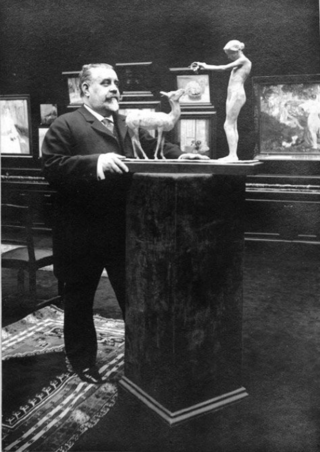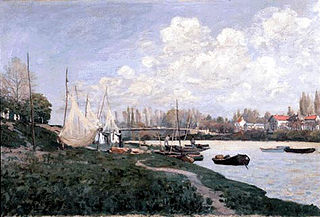
Oscar-Claude Monet was a French painter and founder of impressionist painting who is seen as a key precursor to modernism, especially in his attempts to paint nature as he perceived it. During his long career, he was the most consistent and prolific practitioner of impressionism's philosophy of expressing one's perceptions of nature, especially as applied to plein air (outdoor) landscape painting. The term "Impressionism" is derived from the title of his painting Impression, soleil levant, exhibited in 1874 initiated by Monet and his associates as an alternative to the Salon.

Pierre-Auguste Renoir was a French artist who was a leading painter in the development of the Impressionist style. As a celebrator of beauty and especially feminine sensuality, it has been said that "Renoir is the final representative of a tradition which runs directly from Rubens to Watteau."

Alfred Sisley was an Impressionist landscape painter who was born and spent most of his life in France, but retained British citizenship. He was the most consistent of the Impressionists in his dedication to painting landscape en plein air. He deviated into figure painting only rarely and, unlike Renoir and Pissarro, he found that Impressionism fulfilled his artistic needs.

Paul Durand-Ruel was a French art dealer associated with the Impressionists and the Barbizon School. Being the first to support artists such as Claude Monet, Camille Pissarro, and Pierre-Auguste Renoir, he is known for his innovations in modernizing art markets, and is generally considered to be the most important art dealer of the 19th century. An ambitious entrepreneur, Durand-Ruel cultivated international interest in French artists by establishing art galleries and exhibitions in London, New York, Berlin, Brussels, among other places. Additionally, he played a role in the decentralization of art markets in France, which prior to the mid-19th century was monopolized by the Salon system.

Georges Petit was a French art dealer, a key figure in the Paris art world and an important promoter and cultivator of Impressionist artists.

The Regatta at Sainte-Adresse is an oil-on-canvas painting by the impressionist painter Claude Monet. It was painted in 1867 and is owned by the Metropolitan Museum of Art.

Springtime or The Reader is an 1872 painting by the French Impressionist painter Claude Monet. It depicts his first wife, Camille Doncieux, seated reading beneath a canopy of lilacs. The painting is presently held by the Walters Art Museum.

Dance at Bougival is an 1883 oil-on-canvas painting by the French artist Pierre-Auguste Renoir, currently in the collection of the Museum of Fine Arts in Boston, Massachusetts, United States. Described as "one of the museum's most beloved works", it is one of three in a collection commissioned by Paul Durand-Ruel. It depicts a scene in the French village of Bougival, about 15 km from the center of Paris, a site utilized by many Impressionists besides Renoir including Claude Monet, Alfred Sisley, and Berthe Morisot.

Lise with a Parasol is an oil on canvas painting by French artist Pierre-Auguste Renoir, created in 1867 during his early Salon period. The full-length painting depicts model Lise Tréhot posing in a forest. She wears a white muslin dress and holds a black lace parasol to shade her from the sunlight, which filters down through the leaves, contrasting her face in the shadow and her body in the light, highlighting her dress rather than her face. After having several paintings rejected by the Salon, Renoir's Lise with a Parasol was finally accepted and exhibited in May 1868.

A Young Lady in 1866 or Lady with a Parakeet is an 1866 painting by Édouard Manet, showing his favourite model Victorine Meurent, wearing a pink gown, holding a small bouquet of violettes and accompanied by an African Grey Parrot. It is an oil painting on canvas measuring 185.1 x 128.6 cm, and is now in the Metropolitan Museum of Art in New York. It and Boy Carrying a Sword were the first of Manet's works to enter a gallery collection.

Drying Nets or Fishermen Spreading Their Nets is an 1872 oil-on-canvas painting by Alfred Sisley, now in the Kimbell Art Museum. The painting shows a scene near the village of Villeneuve-la-Garenne.

Ferry to the Ile-de-la-Loge – Flood is a painting by Alfred Sisley. He produced it during a flood on the Seine, which had begun in late October and reached its peak on 17 December. The painting was finished in December 1872. It was bought for 200 francs by Durand-Ruel on 21 January 1873 and exhibited at the First Impressionist Exhibition in April 1874 as number 162 It was later owned by François Depeaux before forming part of the Depeaux sale at the Georges Petit gallery in Paris on 31 May 1906. It was acquired by the Carlsberg Foundation in 1914 and later that year it was exhibited at the Statens Museum for Kunst before being acquired later the same year by its present owner, the Ny Carlsberg Glyptotek in Copenhagen.

The Watering Trough at Marly with Hoarfrost is an 1876 painting by Alfred Sisley. It was owned by François Depeaux, a Sisley collector, and passed through other collections before ending up in that of Paul Mellon. It is now in the Virginia Museum of Fine Arts in Richmond, United States. It was painted at Marly-le-Roi and is part of his Marly series. Sisley's works showing the watering trough and The Flood at Port-Marly are two series of Impressionist masterworks comparable to Claude Monet's Gare Lazare series, Renoir's The Swing and Bal du moulin de la Galette series, Berthe Morisot's Champs de blé series and Camille Pissarro's Vues de Pontoise and Toits rouges series. Sisley did not much change his point of view between each painting, but he dramatically changed the background, proving his ability to vary views of a limited section of countryside.

The Aqueduct at Marly or The Aqueduct at Louveciennes is an 1874 painting by Alfred Sisley. It was bought from the artist by Paul Durand-Ruel in 1876 before being acquired by Edward Libbey, who in turn donated it to the Toledo Museum of Art, where it now hangs. It shows the Aqueduc de Louveciennes. A lifesize reproduction of it is sited at the site of its creation as part of the Pays des Impressionnistes scheme.

The Grand-Rue in Argenteuil is an 1872 painting by Alfred Sisley, previously entitled A Street in Sèvres. It is now in Norwich Castle.

The Church at Noisy-le-Roi, Autumn Effect or The Bell-Tower at Noisy-le-Roi, Autumn Effect is an Impressionist painting by Alfred Sisley.

The Meadow is an 1875 painting by Alfred Sisley, now in section 88 in the National Gallery of Art in Washington DC. It shows a scene near Louveciennes - Pierre-Auguste Renoir painted the same view of Louveciennes that year as Path Through Tall Herbs.

Villeneuve-la-Garenne, Village Beside the Seine or Village on the Seine is an 1872 oil-on-canvas painting by Alfred Sisley, now in the Hermitage Museum in St Petersburg.

Frost in Louveciennes is an 1873 painting by Alfred Sisley, which has been in the Pushkin Museum since 1948. It shows the church of St Martin in the French town of Louveciennes. A chalk sketch for it is now in the Budapest Museum of Fine Arts . The work's early provenance is unknown until on 3 May 1902 Paul Durand-Ruel bought it for 9300 francs at the sale of Jules Strauss's collection at the Hotel Drout auction house. In 1903 Durand-Ruel sold it on to Ivan Morozov - it was one of his first acquisitions. The Pushkin Museum holds a 22 June 1903 letter from Durand-Ruel to Morozov agreeing to sell the work for 11,500 francs, despite this being a big sacrifice for his gallery, and a 27 June receipt for receiving the money.

The Edge of Fontainebleau Forest is an oil on canvas painting by Alfred Sisley, from 1885, now in the Pushkin Museum, in Moscow. On the reverse are the two French titles and labels from Paul Durand-Ruel's Paris and New York. A similar landscape by the artist, In the Forest in Autumn, is now in a private collection in Switzerland.




















